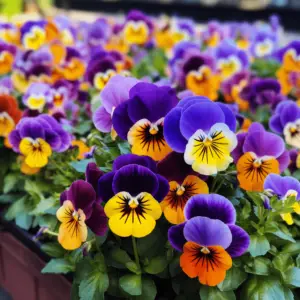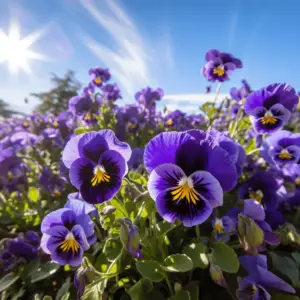The pansy is an astonishingly colorful flower cultivated in most cases annually for its beauty and warmth.
Pansies are sometimes also called violas but this is an inaccuracy since violas are different in foliage but because of similarities in their appearance and other characteristics the two can, and are often confused with each other.
Pansies are large flowers that can span a diameter of 2 – 3 inches and grow to a height of about ten inches.
A pansy has five large petals growing from a central point where a dark-colored hue spreads outward into the petals.
Almost all pansy varieties today are the result of intentional hybridization and as a result, there is no fixed standard for the color of pansies with some even having a total of five colors on a single flower.
Table of Contents
Scorching Summer Heat

Pansies can have red, purple, blue, yellow, white, lilac, and pink. Pansies are perennial plants but are mostly cultivated annually or biennially. They are cool weather plants and will not survive either extreme heat or extreme cold seasons.
The ideal temperature for pansies to thrive is between 45 and 65 degrees Fahrenheit (or 7 – 18 degrees Celsius).
The best time to plant pansies, therefore, is in the spring or in the fall. Spring temperatures favor most plants including pansies. When the summer begins, pansies could die off. They will need protection from the conditions of the season.
Why summer is a cause for concern
Summer temperatures can be as high as 81 degrees Fahrenheit and fall to 52 degrees in some states.
The national average is 79 degrees Fahrenheit or 22 degrees Celsius. Even at the lowest temperature, summer is too hot for pansies to keep thriving.
Sustained high temperatures cause the plant to wilt and begin to wither. Prolonged exposure will stop blooming and as a protective measure, pansies go dormant and will not flower.
As a result, they are often presumed dead and discarded. With a bit of care and conscious effort, pansies could beat the summer heat and make it to the fall.
What to do with pansies in the summer
Water
Pansies need plenty of water throughout in order to keep flowering. Soggy soils are not ideal for most perennials and pansies are no different.
However, a distinctly high amount of water in your soil is necessary to sustain the foliage.
About an inch of water, a week should suffice but it would be much better to bank on daily watering.
In the morning, water pansies generously keeping in mind that a substantial amount could be lost to evaporation as the day progresses.
In the summer, soils are drier which means the soil will also absorb copious amounts of water denying the roots of the pansy much needed hydration.
Pansies do not have strong elaborate root systems and are not adapted to survive dry soils. Water generously in the morning and if they seem to sag and wilt by late afternoon, water them.
Shade
Pansies tolerate heat fairly well. In fact, exposure to the morning sun for a number of hours seems to be good for blooming but in the summer, the heat is constant and too hot.
Without intervention, flowers dry up and over time, lose color becoming gray.
Place pansies in the shade or construct shading over the orchard to stave off some of the direct light.
Apply a light mulch around the base of the plants to provide further protection for the roots.
While this may not change the temperature, it will certainly stop direct sunlight from impacting your pansies all day long.
If you can construct an enclosed shelter, you will have the option to control the temperature of the enclosure like what you have with a greenhouse.
Install a thermostat and bring down the temperature to the desired level approximately 45 – 65 degrees Fahrenheit.
This kind of shelter is a must-have for florists.
Plant Food
Pansies need soils rich in organic material to thrive. In the spring, when most pansies are planted, soils are rich in organic material and many growers improve the soil by adding plant artificial plant food to speed up growth.
By the time the summer comes along, the soils are usually depleted and lacking essential minerals and elements necessary for continued growth.
It is more often the case that the hot sun only impacts pansies negatively because they are lacking the necessary nourishment needed to continue and persevere.
Buy soil testing kits that are available at your local gardening store and test your soil.
Determine specific deficiencies and supplement them with the recommended plant food formula.
Combined with aggressive watering, plant food will go a long way in ensuring your pansies beat the summer and make it to the fall.
Soil Type

Well-drained soils are essential for pansies to thrive. In most cases, poorly drained soils are the problem but in the summer, dry soil will contribute to the death of pansies.
At an average of 70 degrees Fahrenheit, soil loses water incredibly fast, cakes up, and cracks. The delicate root of the pansy plant cannot survive in such soil.
In the summer, well-drained soils lose water very fast through leaching and evaporation.
The best way to deal with this is to mulch aggressively in the summer and water your pansies to compensate for the lost moisture.
Another solution would be to utilize the specific types of soil mixtures recommended for pansies at the point of planting since they are formulated with all considerations of plant growth taken into account.
This way, you will not encounter this hurdle once the summer heat flares and dries the soil.
Select a Resistant Species
Some of these include Springtime, Dynamite, Maxim, and Majestic Giant, developed to withstand high temperatures.
Pansies in general, however, do not perform well in hot weather. Despite their resilience, these heat-resistant species appear to withstand heat spikes such as afternoon sun exposure with cooler temperatures experienced in the night bringing relief.
The constant onslaught of summer heat and dryness still stops blooming and causes them to go dormant. The above interventions should protect your pansies in the summer and see them through to the fall.
